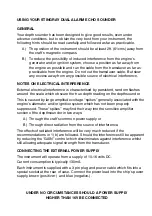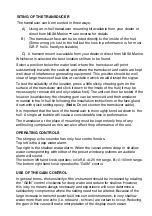
SITING OF THE TRANSDUCER
The transducer can be mounted in three ways:
A)
B)
C)
Using an in-hull transducer mounting kit available from your dealer or
direct from NASA Marine see reverse for details
The transducer face can be bonded directly to the inside of the hull.
(Some energy is lost to the hull but the loss in performance is, for most
G.R.P. hulls, hardly noticeable)
A transom mount is available from your dealer or direct from NASA Marine.
Whichever is selected the best location still has to be found.
Select a position below the water level where the transducer will point
substantially towards the sea bed and where the transducer and cable are kept
well clear of interference generating equipment. This position should be well
clear of large masses of bubbles or cavitation which would disrupt the signal.
To test the suitability of the location, press a little sticky chewing gum on the
surface of the transducer and stick it down to the inside of the hull (it may be
necessary to remove dirt and oily residue first). The unit can then be tested. If the
location is satisfactory the chewing gum can be removed and the transducer
mounted in the in-hull kit following the installation instructions or the face glued
down with quick setting epoxy. (
Note:
Do not shorten the transducer cable).
It is important that the face of the transducer is thoroughly bonded down to the
hull. A single air bubble will cause a considerable loss in performance.
The transducer or the place of mounting must be kept entirely free of any
antifouling compound as this can also affect the performance of the unit.
OPERATING CONTROLS
The stingray echo sounder has only four control knobs.
Top left is the deep water alarm.
Top right is the shallow water alarm. When the vessel enters deep or shallow
water corresponding with either of the preset window positions an audible
alarm will sound.
The bottom left hand knob operates; on/off, A=0-25 mtr range, B=0-100 mtr range.
The bottom right hand knob operates the “GAIN” control.
USE OF THE GAIN CONTROL
In general terms, the sensitivity of the instrument should be increased by rotating
the “GAIN” control clockwise for deep water and reduce for shallow. However,
this is by no means always necessary and experience will soon determine a
satisfactory compromise where the setting need not be altered. Because of the
large increase in transmit power built into current instruments, in very shallow
water more than one echo (i.e. rebound - echoes) are certain to occur. Reducing
the gain in this case will make interpretation of the display much easier.


























